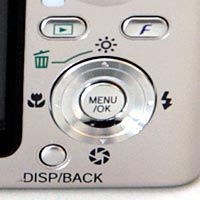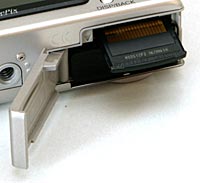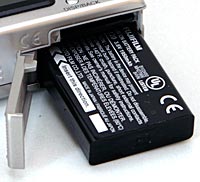Fujifilm Finepix F11
Review Date: January 27th 2006
|
Ease of Use
The Fujifilm Finepix F11 is a compact digital camera that fits into both the palm of your hand and into a trouser pocket. With dimensions of 92 (W) x 27.3 (D) x 58.2 (H) mm and weighing only 155gms, this is a camera that you can slip into a pocket or small bag and not notice until you need to use it. During the course of this review, I carried the Fujifilm Finepix F11 with me virtually all of the time, resulting in photos that I otherwise may not have taken at all. The Fujifilm Finepix F11 is perhaps not the most stylish or eye-catching camera that you will ever see, with quite a boxy design that is only made slightly more interesting by the sloping handgrip on the front. The overall finish of the Fujifilm Finepix F11 is very good though. Despite being made entirely of plastic, it has a reassuring heft and it looks and feels a more expensive than it actually is.
The Fujifilm Finepix F11 is comfortable to hold, thanks to the protruding handgrip on the front of the camera and the indented area underneath the zoom switch where your right thumb is naturally positioned. Your right forefinger is then free to operate the shutter button, whilst your thumb controls the zoom. You can also comfortably hold the camera and take pictures with one hand. Despite the smooth all-plastic body, the camera is not too slippy when gripping it. The various buttons are well-made and easy to operate (although the Display button on the rear is a little too recessed), and the camera feels well-balanced in your hands. There are no real innovative features here, but everything that the Fujifilm Finepix F11 does, it does well. Overall the Fujifilm Finepix F11 is well constructed and designed with no obvious signs of corners being cut.
The Fujifilm Finepix F11 has relatively few external controls, just 9 in total, which is surprising considering that this camera offers a full range of photographic controls. You can directly access the various flash, aperture/shutter speed, macro and delete options by clicking on the four buttons around the navigation pad. As with most other Fujfilm digital cameras, the Fujifilm FinePix F11 has a Menu button on the rear of the camera which, as you would expect, gives you access to the software menu system. This lets you set various parameters including exposure compensation, shooting mode (aperture-priority, shutter-priority or manual), white balance and so on.
There is also a small silver button with an F on it, which opens what Fujifilm call the Photo Mode menu. This allows you to control the file quality setting, ISO speed and colour settings (B&W, Chrome or Standard). I'm not really sure why these 3 settings alone should fall under the heading of Photo Mode, and things like white balance are just part of the standard menu. And I'm undecided about whether it is a good idea or not. The F button does give quick access to certain features, but you do have to memorise what another button does. I also wish that Fujifilm had included external buttons for the shooting mode and exposure compensation options, as having to change what are frequently used options through the menu system slows down the overall operation of the camera.
| The Major Controls | Power Button/ Mode Dial / Shutter Button |
 |
 |
The shutter button on top of the camera is surrounded by a dial that you turn to select the various shooting modes (Movie, A/S/M, Auto and Scene modes). It works well, although it is quite prominent and looks a little out of place on what is otherwise an understated and uncluttered camera interface. All 9 external controls are clearly labeled using industry-standard symbols and terminology. Overall the camera body feels very well-designed and not at all cluttered, despite the presence of the large 2.5 inch LCD screen. Note that there is no optical viewfinder on the Finepix F11, leading to a few moments of frustration in very bright sunlight when it can be difficult to see the image on the monitor clearly.
If you have never used a digital camera before, or you're upgrading from a more basic model, reading the comprehensive and fairly easy-to-follow 130-page manual before you start is a good idea. Thankfully Fujifilm have bucked the recent trend of not providing hard-copy manuals and decided to supply it in printed format.
The main menu system on the Fujifilm Finepix F11 is straight-forward to use and is accessed by pressing the Menu/OK button in the middle of the navigation pad. A vertical row of two tabbed pages along the left sided of the LCD screen represents the sub-menus, with 6 options in the first one one and 3 options in the second. At the bottom of the second tab is the Setup option - select this to access 4 more tabbed pages (each with 6 options) which contain options that you will probably set once and then forget about. Due to the large LCD screen, the various options and icons are perfectly easy to read.
The Fujifilm Finepix F11 offers a range of advanced exposure modes, including shutter-priority, aperture-priority and manual, perfect for the photographer who wants to take full control. The system used to actually set the aperture or shutter speed works quite well. In the two semi-automatic modes, you press the down arrow on the navigation pad, and then press left and right to select an aperture/shutter speed. The manual mode is actually misleading, in that it does not allow you to set both the aperture and shutter speed at the same time. Instead, the camera actually sets the aperture/shutter speed, whilst you can change all of the other settings (white balance, exposure compensation and so on). If you buy the Fujifilm Finepix F11 because you think it has a proper manual exposure mode, then you will be sorely disappointed.
| Memory Card Slot | Battery Compartment |
 |
 |
There are some other notable missing features that will disappoint the photographer in you, and which I think Fujifilm should really have added to the Finepix F11. Firstly there is no manual focus mode, which is fine for most of the time as the camera's auto-focus usually locks onto your intended target, but is an annoying omission on the occasions when it struggles (usually in low-light). An infinity mode for landscapes would have been a good idea, but this is also missing. Somewhat amazingly, Fujifilm have not included a histogram, either in shooting mode or image playback. Most if not all of their recent advanced cameras have this important feature, so it's pretty unforgivable not to include it on a camera that is aimed at the serious photographer. Finally there is no RAW mode, which may or may not be a deal-breaker for you.
The start-up time from turning the Fujifilm Finepix F11 on to being ready to take a photo is very quick at around 0.75 second, and it takes about 1.5 seconds to zoom from the widest focal length to the longest, and back again. Focusing is very quick in good light and the camera achieves focus most of the time indoors or in low-light situations, helped by a powerful focus-assist lamp. The camera does sometimes struggle to lock on at the long-end of the zoom though. The visibility and refresh rate of the 2.5 inch LCD screen are perfectly acceptable, and the resolution is perfectly adequate. It takes about 2 seconds to store an image, allowing you to keep shooting as they are being recorded onto the memory card - there is no LCD blackout between each image. In Continuous mode the camera takes 2.2 frames per second at the highest image quality, which is fairly quick for this class of camera, and best of all this shooting rate can be maintained for up to 40 frames. All in all the Fujifilm Finepix F11 is quite fast in terms of operational speed.
Once you have captured a photo, the Fujifilm Finepix F11 has a good range of options when it comes to playing, reviewing and managing your images. You can scroll through the images that you have taken, view thumbnails, zoom in and out, sort images by date, view slideshows with lots of different settings, delete, protect, trim and rotate an image. You can also add a sound clip to an image, set the print order and the transfer order. The Disp button toggles detailed settings information about each picture on and off, such as the ISO rating and aperture/shutter speed. As noted above, there is no histogram.
In summary the Fujifilm Finepix F11 is a compact, well built and easy to use digital camera that offers a lot of creative control, but which also has some annoying omissions in its feature set.
|
 PhotographyBLOG
is a member of the DIWA
organisation. Our test results for the Fujifilm Finepix F11
have been submitted to DIWA
for comparison with test results for different samples of
the same camera model supplied by other DIWA
member sites.
PhotographyBLOG
is a member of the DIWA
organisation. Our test results for the Fujifilm Finepix F11
have been submitted to DIWA
for comparison with test results for different samples of
the same camera model supplied by other DIWA
member sites.
